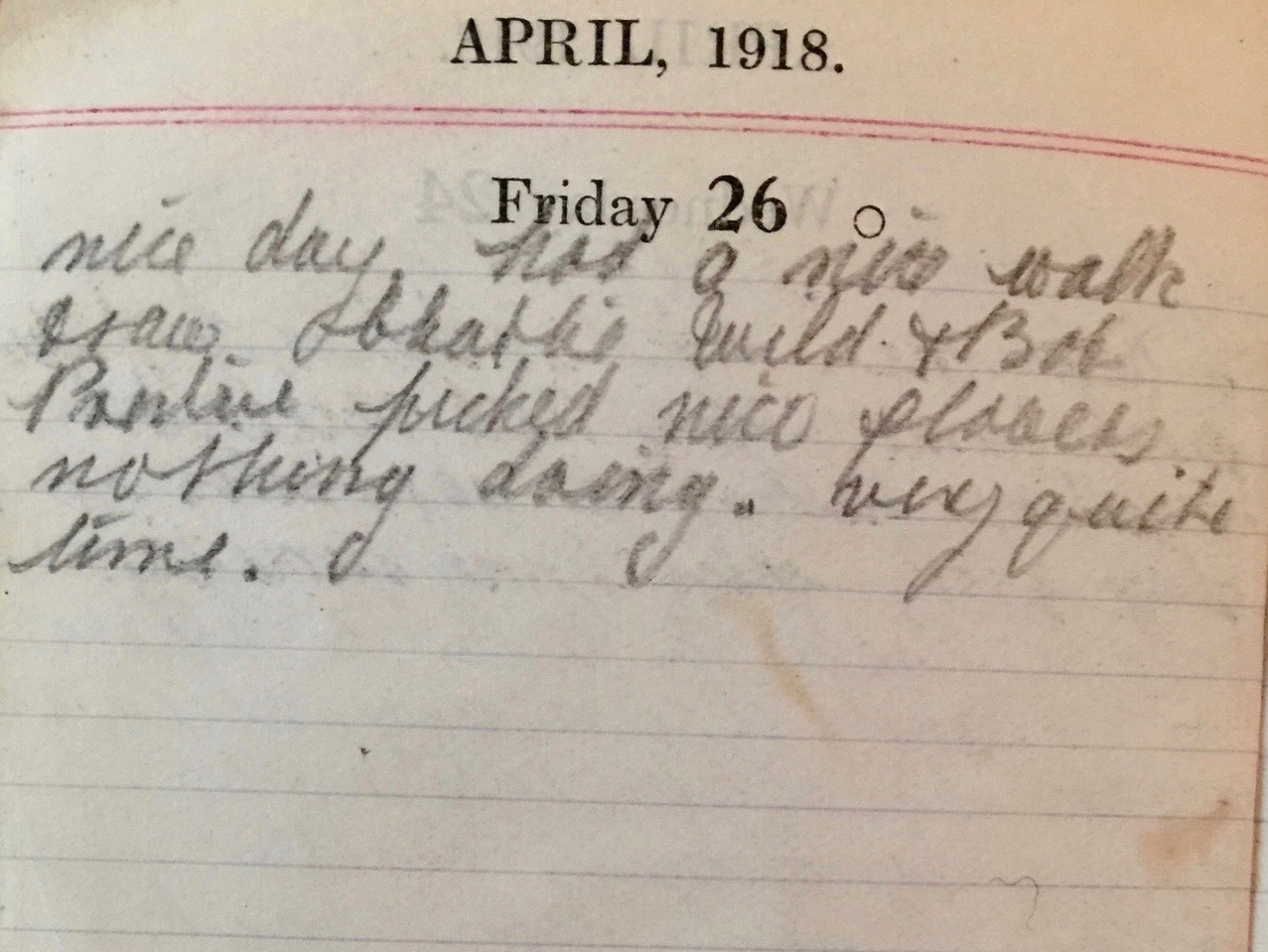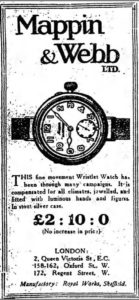Friday April 26th, 1918
Nice day. Had a nice walk & saw Charlie Wild and Bob Prentise. Picked nice flowers. Nothing doing. Very quiet time.
Night Patrols
We have read a lot about night patrols over the past few days. According to ‘Scouting & Patrolling’, there are three purposes for night patrols: to gain information; to kill, capture or harass the enemy; and to protect other troops.
While Frank has the day off, tonight 2Lt Fazackerley goes out with a small party. Its objectives seem to be a combination observation and the hunt for prisoners. Their plans to capture two enemy soldiers is scuppered by the arrival of another half a dozen. This was a lucky escape as, in retreat, Fazackerley’s patrol realize the enemy outnumbers them three to one. There was a brief exchange of fire and it appears one of the enemy was shot.
‘Scouting & Patrolling’ provides detail of the training that night parties require. These include listening, interpreting sounds (e.g. the sound of digging or men walking), assessing distances, not being heard and seeing without being seen. It continues, ‘Many a casualty has occurred from a want of thought. A luminous wrist watch, striking a match, a lantern torch or cigarette exposed are often causes of fatal results.’ ¹
Captain Stewart recalled his first night out with a wiring party on April 3rd, 1916, ‘This was my first night out in ‘no man’s land’ and it is a wonder it was not my last. The men I took knew it was my first time out and I was afraid of them thinking I was afraid. We made a hell of a noise about it and must have annoyed the Boche, who may have thought we were going to raid them. We drew a lot of riled fire from their front line, and then they started throwing bombs at us from an old mine crater.’ Luckily a Stokes gun team was nearby and got involved, thereby enabling the party to get back to the safety of its trench.
Wristwatches
The standard timepieces at the start of the Great War were pocket watches. These were impractical and easily lost. This caused the rise of the wristwatch which during the war were known as “officers” or “trench” watches.²
In the later years of the war some wristwatches were issued, probably to other ranks who needed to know the time, such as signallers.
Captain Lake’s 1916 publication ‘Knowledge for war, every officer’s handbook for the Front’ contained a list of ‘Officer’s Kit for the Front’. ‘A luminous wristwatch with unbreakable glass’ appeared as the first item on this list, above a ‘revolver‘ and much higher than the a ‘pair of pyjamas‘ and a ‘flea bag‘.³
The book also had at least two advertisements for wristwatches, not least Mappin & Webb’s Campaign Watch, complete with luminous dial, for £2:10:0. See this similar advertisement from The Observer newspaper in 1917.*
Luminous dials were popular but radioactive as they were painted with radium. In the early part of the 20th century, radium was thought to be a ‘wonder’ and put into face creams and even underwear. The women who were employed to paint watch faces, and encouraged to put the brush between their lips to get it to a point, suffered horrendously – first as a result of mis-information and then of the manufacturers’ greed.º
13th (Service) Battalion War Diary – 26th April 1918 – Crow Hill
Our artillery was active as usual, enemy’s was only moderately active. Our observation planes were over enemy lines all day. 1 enemy plane crossed our lines at 09:40 hrs travelling south, it returned at 10:15 hrs. Enemy observation balloon rose from near Keisberg from 17:45 to 18:25 hrs.
2Lt J Fazackerley and 4 OR proceeded via Lancaster Hill to Kimberley Spur, crossed trenches on E slope of latter, negotiated three belts of wire, (found to be in a rather poor condition) and halted a few yards in rear of forward trench running approximately E and W. Here patrol lay up for a while owing to bright moonlight. Hammering of stakes was hear in approximate direction of pt 1827/1205. An advance was about to be made when two enemy were observed approaching higher up the Spur. They halted about 20 yds away and took cover behind small bushes. They had apparently not observed the patrol as they left cover after a few seconds and continued to advance.The patrol was preparing to capture them when six or seven more enemy appeared. Fearing the patrol would be cut off on the left where field of view was rather limited, patrol leader move to the left and discovered the enemy party numbered twelve. Fire was opened up by our patrol enemy dropped down and a shout was heard, apparently one was hit. Patrol withdrew into Japhet Ravine without any enemy retaliation. Nothing more was seen of enemy and patrol returned to our lines by 23:30 hrs.
Patrol reports that the ground falls away sharply N of Goldies IV, the N side of Goldies I is thickly covered with trees and scrub, there are three large sangars on N side of Goldies I. The wire on White Scar Hill has been continued down the hill into the ravine, facing Goldies throughout. A new line of enemy trenches about 1400 yards long with 5 CT running back has been dug during the night 25/26 April. The trench runs approximately from pt 1169/18175 about 300 yds in front o fate old line until it rejoins the old line near POB F. The trench is estimated to be 1 ft 6 inches deep. Visibility was high all day. 1st Day of Divisional Military Recreational Training Meet. Our bombing team was beaten. Its approach and attack along the trench was as good as any team but it got nervous in the throwing and made bade shooting.
References & Further Reading
¹ ‘Scouting & Patrolling‘ (Issued by the General Staff) December, 1917, page 23
² ‘The Great War, Officers, Watches and Trench Wristwatches‘ on Vintage Watch Straps site.
³ ‘Knowledge for war, every officer’s handbook for the Front‘ by Captain B. Lake, on page 177 at archive.org
º ‘The forgotten factory girls killed by radioactive poison‘, by Kate Moore, June 14th, 2016 in The Telegraph
* Advertisement appeared in The Observer, March 4th, 1917 (image may be subject to copyright)



